Phone and Network Cables
We will use
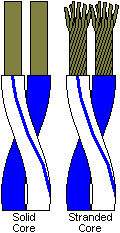
Another term you will hear a lot while shopping for
There are other practical differences between

The four wire pairs in a
| CAT-5 Wire Order | ||||
| Pair # | Wire Color | Abbr. | Wire # (Pair) |
Wire # (Cable) |
| 1 | White/Blue | W/B | 1 | 1 |
| Blue | B | 2 | 2 | |
| 2 | White/Orange | W/O | 1 | 3 |
| Orange | O | 2 | 4 | |
| 3 | White/Green | W/G | 1 | 5 |
| Green | G | 2 | 6 | |
| 4 | White/Brown | W/Br | 1 | 7 |
| Brown | Br | 2 | 8 | |
Strictly speaking, each colored pair consists of
(in order) a white wire with a colored stripe and a colored wire with a white
stripe. However, the rules for cables with so few pairs are lax. Most often you
will find the pairs consisting of a white wire with a colored stripe and
a solid colored wire. Sometimes the white wire may not even have a stripe
(it may have dots or just be associated by the color of the
wire it's twisted with), and sometimes it's not even white (being gray or transparent).
Some cable has all solid colors in untwisted pairs (avoid completely as it
is not
The table at right shows the order of the wire pairs. The color standard covers cables with more than four pairs, but that is out of the scope of this discussion.
Phone and network connections both use a "Registerd
Jack" (RJ) type connector. Phones use
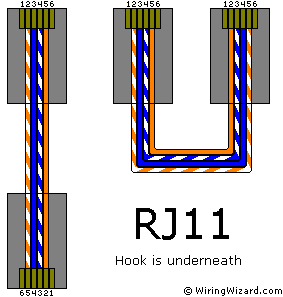 |
| Figure 1: Click on picture to switch cable types |
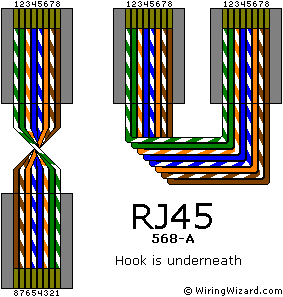 |
| Figure 2: Click on picture to switch standards |
Typical phones use 4 or 6 pin
| Bad RJ (Click) |
Wires in
Network and ISDN cables use 8 pin
Wires in
Note that for the
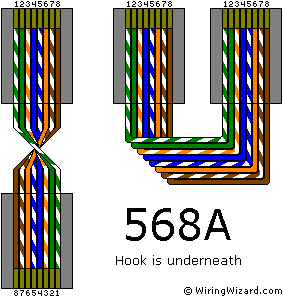 |
| Figure 3: Click on picture to hide/show unused wires |
The two standards reverse where pair 2 (orange) & pair 3 (green) are pinned. As it happens, these are the only wires that are used in network cables. Network protocol does not use pair 1 (blue) or pair 4 (brown). You can click on the pictures to hide and show the unused pairs. ISDN cables use all four pairs.
Both standards are completely compatible with all network and ISDN equipment and each other.
You can plug a
We recommend the
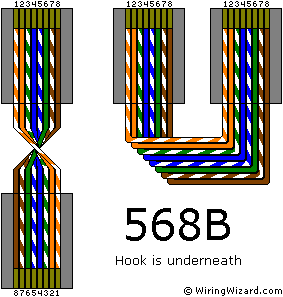 |
| Figure 4: Click on picture to hide/show unused wires |
The
The drawback is most off-the-shelf equipment is wired to the
Crossed vs. Straight Cables
| Crossed Cables | |
| Pin | Pin |
| 1 | 6 |
| 2 | 5 |
| 3 | 4 |
| 4 | 3 |
| 5 | 2 |
| 6 | 1 |
Phone cables are logically "crossed". A pin on
one end of a crossed cable does not lead to the same pin on the
other end. Instead, it leads to it's mirror opposite on the other end. When you
hold the two ends of a phone cable in the same direction, one is wired in
the reverse sequence of the other (see Figure 1 above). This is not
the same as a
Figure 1 above and the table on the right show where a pin on one end of a crossed cable leads to on the other end. The same concept also applies to phone cables with only 4 or 2 wires.
Note that the concept only applies
to
| Straight Cables | |||
| Pin | Pin | ||
| 1 | T+ | 1 | T+ |
| 2 | T- | 2 | T- |
| 3 | R+ | 3 | R+ |
| 4 | 4 | ||
| 5 | 5 | ||
| 6 | R- | 6 | R- |
| 7 | 7 | ||
| 8 | 8 | ||
Network and ISDN cables are logically "straight". A pin on one end of a straight cable always leads to the same pin on the other end. When you hold the two ends of a network cable in the same direction, both are wired in the same sequence (see Figure 2 above).
Figure 2 above and the table on the left show where a pin on one end of a straight cable leads to on the other end.
Network and ISDN cables are logically straight whether they have
To further add to the confusion, a logically crossed cable can physically lay flat (looking very straight) when put on a table with the hook underneath at both ends (see Figure 1 above). A logically straight cable must be physically twisted 180 degrees (looking very crossed) to lay on a table with the hook underneath at both ends (see Figure 2 above).
The good news is that the phone wiring discussed in this site will deal entirely
with logically straight cables. We will use
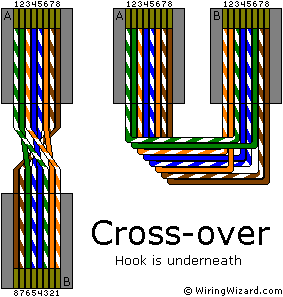 |
| Figure 5: Cross-over Cable Click on picture to hide/show unused wires |
Two computers can be connected directly using a
| Cross-over Cables | |||
| Pin | Pin | ||
| 1 | T+ | 3 | R+ |
| 2 | T- | 6 | R- |
| 3 | R+ | 1 | T+ |
| 4 | 4 | ||
| 5 | 5 | ||
| 6 | R- | 2 | T- |
| 7 | 7 | ||
| 8 | 8 | ||
Figure 5 at right and the table on the left show where a pin
on one end of a
A subtle but helps-you-remember-how-to-do-it result of
this swaping is that one end is wired
All contents and scripts copyright © 2000, WiringWizard.com